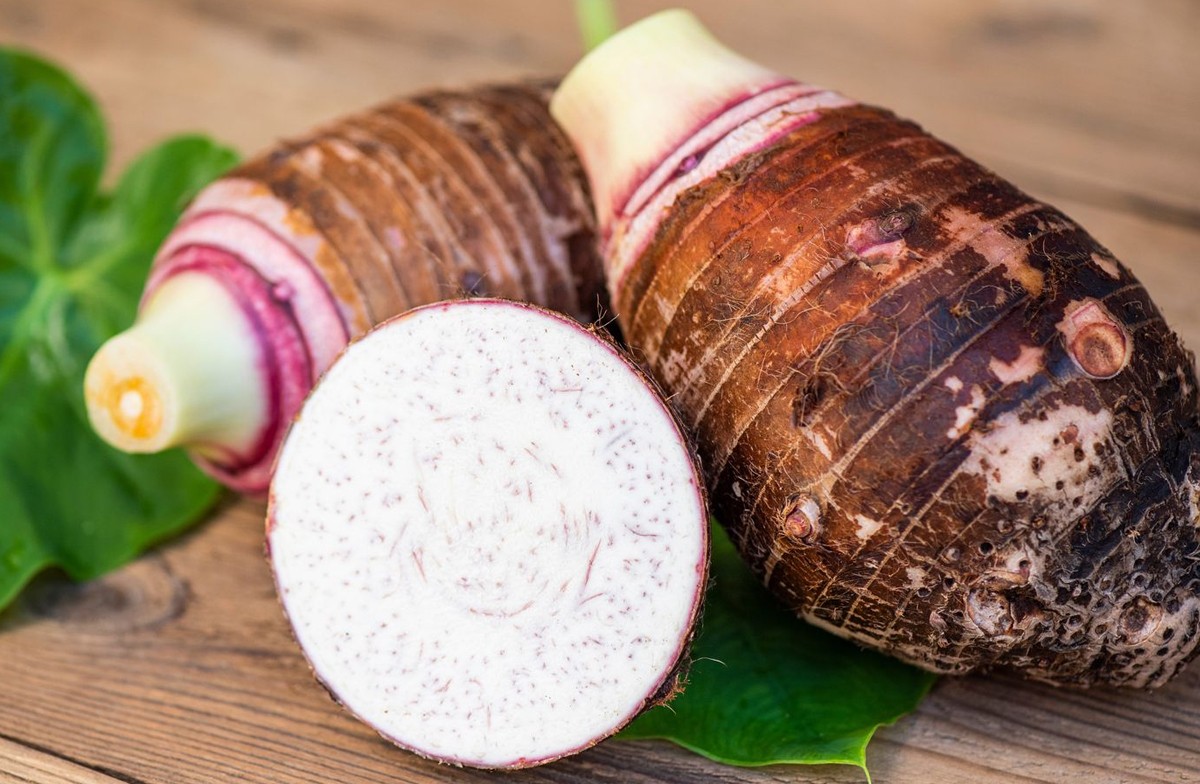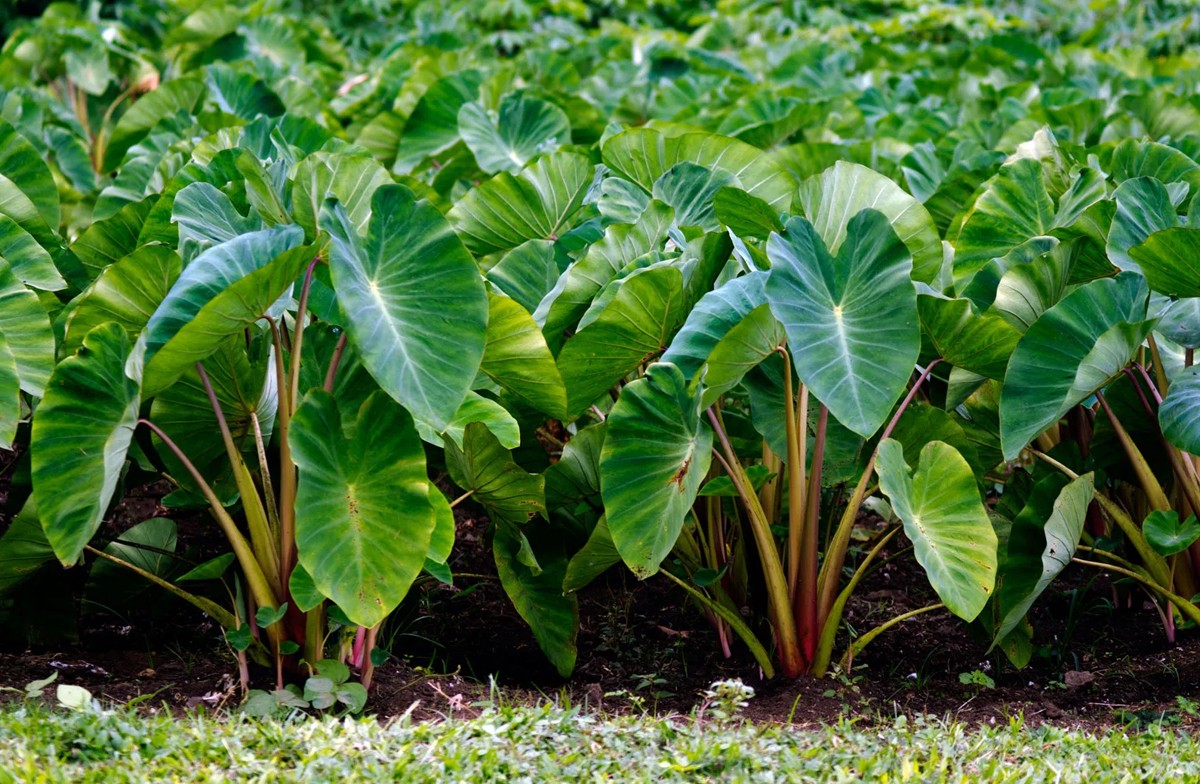Taro
The taro plant is native to Southeast Asia but is now grown and consumed in many parts of the world. It is a staple food in various cuisines and has a distinct flavor and texture. The leaves of the taro plant are also edible and used in cooking in some cultures.
The cooling nature of taro is believed to help clear heat and reduce internal heat-related symptoms. Its sweet taste contributes to its nourishing and harmonizing properties. Taro is primarily associated with the Spleen, Stomach, and Lung meridians in natural health, indicating its relevance in supporting digestion, strengthening the spleen, and benefiting respiratory health.
In natural health, taro is known as "Yu Tou" or "Fu Shen." It is valued for its therapeutic properties and is used in various ways:
- Nourishing the Spleen and Stomach: Taro is believed to strengthen the digestive system and promote healthy digestion. It is often recommended for individuals with weak digestive function, poor appetite, or loose stools.
- Harmonizing Qi and Blood: Taro is considered to have a harmonizing effect on the flow of Qi (vital energy) and blood in the body. It is used to address symptoms of Qi and blood stagnation, such as abdominal pain, menstrual irregularities, and chest congestion.
- Diuretic and Detoxifying Effects: Taro is thought to have diuretic properties and is used to promote urine production and eliminate toxins from the body. It is often used in cases of edema, urinary difficulties, or to support kidney health.
- Cooling and Moistening: Taro is considered a cooling food that can help reduce internal heat and clear heat-related symptoms. It is used for conditions such as excessive thirst, mouth sores, and skin inflammations.
- Nutritional Support: Taro is a good source of nutrients, including dietary fiber, vitamins, and minerals. It is valued for its ability to provide nourishment and support overall health and well-being.
Taro nutritional benefits
- Dietary Fiber: Taro is a good source of dietary fiber, which aids in digestion, promotes regular bowel movements, and helps maintain a healthy weight.
- Vitamins and Minerals: Taro contains various vitamins and minerals, including vitamin E, vitamin C, potassium, magnesium, and manganese. These nutrients support immune function, promote healthy skin, assist in energy production, and contribute to overall well-being.
- Complex Carbohydrates: Taro is rich in complex carbohydrates, which provide sustained energy and help regulate blood sugar levels. This makes it a suitable food choice for individuals seeking to manage their blood sugar levels.
- Antioxidants: Taro contains antioxidants such as beta-carotene and vitamin C, which help protect the body against oxidative stress and reduce the risk of chronic diseases.
- Resistant Starch: Taro contains resistant starch, a type of starch that resists digestion in the small intestine. Resistant starch acts as a prebiotic, promoting the growth of beneficial gut bacteria, improving gut health, and supporting overall digestive health.
- Low in Fat: Taro is naturally low in fat, making it a healthier alternative to high-fat foods.
It's worth noting that the specific nutritional content of taro can vary depending on the variety, preparation method, and cooking technique. Adding taro to a well-balanced diet can contribute to a nutritious and wholesome eating plan.
In Person With Heshoutang Natural Health Members
With Heshoutang Natural Health Online Members
Fill Out the Questionnaire by yourself
Taro Pharmacology
Taro, known scientifically as Colocasia esculenta, has been studied for its pharmacological properties and potential health benefits. While much of the research has focused on specific compounds found in taro rather than the whole plant, here are some pharmacological aspects associated with taro:
- Antioxidant Activity: Taro contains various antioxidants, including phenolic compounds and flavonoids, which help protect against oxidative stress and reduce the risk of chronic diseases such as cardiovascular diseases and certain types of cancer.
- Anti-inflammatory Effects: Certain compounds found in taro, such as flavonoids and polyphenols, possess anti-inflammatory properties. They may help reduce inflammation in the body and potentially alleviate symptoms associated with inflammatory conditions.
- Antimicrobial Activity: Studies have shown that extracts from taro leaves and corms exhibit antimicrobial activity against various pathogens, including bacteria and fungi. This suggests potential applications in the treatment or prevention of microbial infections.
- Anti-diabetic Potential: Some research suggests that taro extracts may have anti-diabetic properties. They may help regulate blood sugar levels and improve insulin sensitivity, making it potentially beneficial for individuals with diabetes or at risk of developing diabetes.
- Anti-cancer Properties: Certain compounds found in taro, such as polyphenols, have shown anti-cancer activities in laboratory studies. They may help inhibit the growth of cancer cells and protect against certain types of cancer. However, more research is needed to fully understand the mechanisms and potential therapeutic applications.
How to plant taro
To plant taro, you can follow these general steps:
- Climate and Location: Taros thrive in tropical or subtropical climates with warm temperatures and high humidity. Choose a location with partial shade or filtered sunlight, as direct sunlight can scorch the leaves. Ensure the soil is rich, loamy, and well-draining.
- Taro Corms: Obtain taro corms, which are the underground stems or tubers from which new plants grow. You can find them at nurseries, garden centers, or through online suppliers.
- Preparing the Corms: Soak the taro corms in water for a few hours to encourage sprouting. This step can help activate the growth process.
- Planting: Dig a hole in the soil, about 4-6 inches deep. Place the taro corm horizontally in the hole, with the bud side facing up. Cover the corm with soil, leaving the bud exposed. Space the corms about 2-3 feet apart to allow enough room for growth.
- Watering: Keep the soil consistently moist but not waterlogged. Taro plants require regular watering to ensure the soil remains damp. Avoid overwatering, as it can lead to root rot.
- Mulching: Apply a layer of organic mulch, such as straw or wood chips, around the plants. Mulching helps retain moisture, suppress weeds, and provide nutrients to the growing taro plants.
- Maintenance: Remove weeds regularly to prevent competition for nutrients and water. Monitor the plants for any signs of pests or diseases and take appropriate measures if needed.
- Harvesting: Taro is typically ready for harvest around 8-12 months after planting, depending on the variety and growing conditions. The leaves will start turning yellow, indicating that the corms are ready for harvest. Carefully dig around the plant to unearth the corms without damaging them.
It's important to note that specific planting and care instructions can vary depending on your region, climate, and taro variety. It's advisable to consult local gardening resources or seek guidance from experienced gardeners in your area for more specific instructions tailored to your location.
When you subscribe to the blog, we will send you an e-mail when there are new updates on the site so you wouldn't miss them.


















Comments